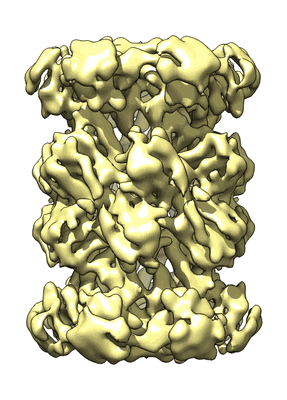EMD-5616
Yeast 20S proteasome with C-terminal peptide of yeast Rpt1
EMD-5616
Single-particle7.9 Å
 Deposition: 21/03/2013
Deposition: 21/03/2013Map released: 15/05/2013
Last modified: 05/06/2013
Sample Organism:
Saccharomyces cerevisiae
Sample: Yeast 20S proteasome
Deposition Authors: Li X, Kim HM, Cheng Y
Sample: Yeast 20S proteasome
Deposition Authors: Li X, Kim HM, Cheng Y

Reconfiguration of the proteasome during chaperone-mediated assembly.
Park S,
Li X,
Kim HM,
Singh CR,
Tian G,
Hoyt MA,
Lovell S,
Battaile KP  ,
Zolkiewski M,
Coffino P,
Roelofs J
,
Zolkiewski M,
Coffino P,
Roelofs J  ,
Cheng Y
,
Cheng Y  ,
Finley D
,
Finley D
(2013) Nature , 497 , 512 - 516
 ,
Zolkiewski M,
Coffino P,
Roelofs J
,
Zolkiewski M,
Coffino P,
Roelofs J  ,
Cheng Y
,
Cheng Y  ,
Finley D
,
Finley D
(2013) Nature , 497 , 512 - 516
Abstract:
The proteasomal ATPase ring, comprising Rpt1-Rpt6, associates with the heptameric α-ring of the proteasome core particle (CP) in the mature proteasome, with the Rpt carboxy-terminal tails inserting into pockets of the α-ring. Rpt ring assembly is mediated by four chaperones, each binding a distinct Rpt subunit. Here we report that the base subassembly of the Saccharomyces cerevisiae proteasome, which includes the Rpt ring, forms a high-affinity complex with the CP. This complex is subject to active dissociation by the chaperones Hsm3, Nas6 and Rpn14. Chaperone-mediated dissociation was abrogated by a non-hydrolysable ATP analogue, indicating that chaperone action is coupled to nucleotide hydrolysis by the Rpt ring. Unexpectedly, synthetic Rpt tail peptides bound α-pockets with poor specificity, except for Rpt6, which uniquely bound the α2/α3-pocket. Although the Rpt6 tail is not visualized within an α-pocket in mature proteasomes, it inserts into the α2/α3-pocket in the base-CP complex and is important for complex formation. Thus, the Rpt-CP interface is reconfigured when the lid complex joins the nascent proteasome to form the mature holoenzyme.
The proteasomal ATPase ring, comprising Rpt1-Rpt6, associates with the heptameric α-ring of the proteasome core particle (CP) in the mature proteasome, with the Rpt carboxy-terminal tails inserting into pockets of the α-ring. Rpt ring assembly is mediated by four chaperones, each binding a distinct Rpt subunit. Here we report that the base subassembly of the Saccharomyces cerevisiae proteasome, which includes the Rpt ring, forms a high-affinity complex with the CP. This complex is subject to active dissociation by the chaperones Hsm3, Nas6 and Rpn14. Chaperone-mediated dissociation was abrogated by a non-hydrolysable ATP analogue, indicating that chaperone action is coupled to nucleotide hydrolysis by the Rpt ring. Unexpectedly, synthetic Rpt tail peptides bound α-pockets with poor specificity, except for Rpt6, which uniquely bound the α2/α3-pocket. Although the Rpt6 tail is not visualized within an α-pocket in mature proteasomes, it inserts into the α2/α3-pocket in the base-CP complex and is important for complex formation. Thus, the Rpt-CP interface is reconfigured when the lid complex joins the nascent proteasome to form the mature holoenzyme.
